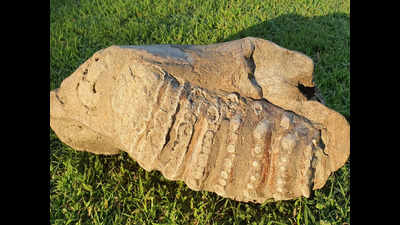- News
- City News
- meerut News
- 8 million-year-old fossil of jumbo, whose tusks grew up to 12 feet, found in UP
Trending
This story is from June 20, 2020
8 million-year-old fossil of jumbo, whose tusks grew up to 12 feet, found in UP
A camera trap survey in UP Shivalik range forests led officials and wildlife experts to a rare discovery this week. Lying in a shallow water stream just 50km north of Saharanpur city in Badshahi Bagh was an unusually long stone that caught the team's eye. Upon a closer look, they agreed it was a unique fossil.

The 2ft-long fossil is the first such find in Shivalik range, say experts.
MEERUT: A camera trap survey in UP Shivalik range forests led officials and wildlife experts to a rare discovery this week. Lying in a shallow water stream just 50km north of Saharanpur city in Badshahi Bagh was an unusually long stone that caught the team's eye. Upon a closer look, they agreed it was a unique fossil.
The 2-feet-long specimen was sent to Dehradun-based Wadia Institute of Himalayan Geology which confirmed that the fossil was the lower jaw of a Stegodon, an extinct relative of the modern Asian elephant, that likely dates back five to eight million years .
"It's the first such find in UP's Shivalik range," said associate coordinator with WWF India, Dehradun, Dr Ponappa Bopanna.
 The 2-feet-long specimen has been confirmed as the lower jaw of a Stegodon.
The 2-feet-long specimen has been confirmed as the lower jaw of a Stegodon.
 The fragment was dated using magnetostratigraphy.
The fragment was dated using magnetostratigraphy.
The scientist added, “In the current specimen, we can also identify the third lower molar and see nine clear ridges. The length of the molar is nearly 24 cm and it has a thick enamel.” The fragment was dated using magnetostratigraphy. “The technique relies on the ability of sedimentary rocks to acquire remanent magnetisation when they form which can help pin down the geological age. The age of the fossil specimen ranges between five to eight million years,” said Sehgal.
Previously, Stegodon fossils have been found in Saketi in Himachal Pradesh, 76 km from the site of the new find, and other areas on Shivalik Hills such as Kala Amb in Haryana and foothills of Jammu. Stegodon fossils discovered in China are believed to be between eight million to 11 million years old.
Read this story in Bengali
The 2-feet-long specimen was sent to Dehradun-based Wadia Institute of Himalayan Geology which confirmed that the fossil was the lower jaw of a Stegodon, an extinct relative of the modern Asian elephant, that likely dates back five to eight million years .
"It's the first such find in UP's Shivalik range," said associate coordinator with WWF India, Dehradun, Dr Ponappa Bopanna.

Scientists at Wadia institute said the fossil belonged to a Stegodon calf. Scientist R K Sehgal said, "The moderately preserved fossil is mandibular ramus (part of lower jaw). Stegodon preceded Elephas Maximus (the Asian Elephant). The species had tusks that grew 10-12 feet."

The scientist added, “In the current specimen, we can also identify the third lower molar and see nine clear ridges. The length of the molar is nearly 24 cm and it has a thick enamel.” The fragment was dated using magnetostratigraphy. “The technique relies on the ability of sedimentary rocks to acquire remanent magnetisation when they form which can help pin down the geological age. The age of the fossil specimen ranges between five to eight million years,” said Sehgal.
Previously, Stegodon fossils have been found in Saketi in Himachal Pradesh, 76 km from the site of the new find, and other areas on Shivalik Hills such as Kala Amb in Haryana and foothills of Jammu. Stegodon fossils discovered in China are believed to be between eight million to 11 million years old.
Read this story in Bengali
End of Article
FOLLOW US ON SOCIAL MEDIA










